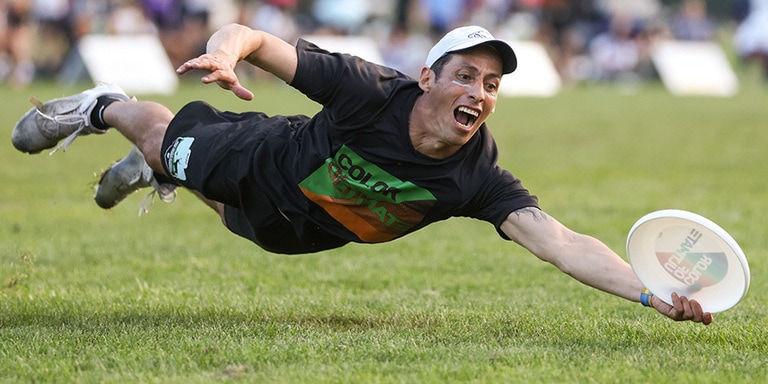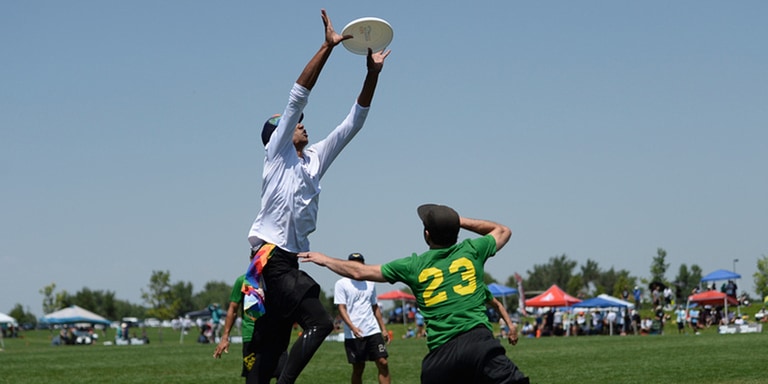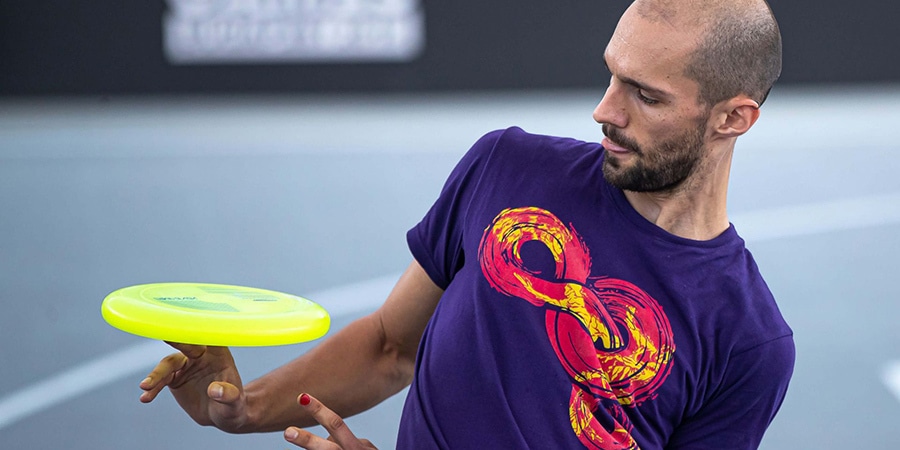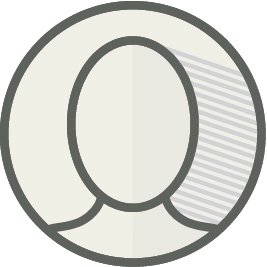You may find flying discs soaring through the air on sandy beaches, in city parks and across college campuses. Often multiple people are in on the fun, exchanging laughs and encouragement as they toss and catch. Sometimes solo throwers launch the disc into the air, move their body in a series of spins and then nimbly catch the disc one-handed. Occasionally Fido gets in on the action, snagging discs midflight.
Over the years, countless disc sports and games have gained traction around the world. The Pluto Platter—a forerunner to the famous Frisbee—was the first mass-produced recreation disc, imprinted with the phrase "Play Catch—Invent Games" and sold beginning in 1954, notes Robert "Nob" Rauch, president of the World Flying Disc Federation (WFDF). Since then, the popularity and diversity of flying disc games and sports have only increased. Some disc activities are variations of popular ball sports that require athleticism, challenging participants to chase after a flying disc panting, "I think I can get it," laughs professional ultimate player Joe "Smash" Anderson. Other disc sports are a graceful artform unto themselves. Most are an "affordable way to get active and find community," says Danny Voss, Professional Disc Golf Association (PDGA) director of marketing.
This guide will first discuss the benefits of disc sports, a brief history of disc sports and games, and answer some frequently asked questions about flying discs.
Here is a list of disc activities included in this guide: You can click each link for information about that particular sport or game, or scroll to read more.
Crosbee A lacrosselike team game played with discs on a field
Discathon A kind of relay race involving each competitor throwing discs toward the finish line
Disc dog A throw-and-catch game played by a human and a canine
Disc golf An individual or team sport involving landing your disc into a target
Double disc court A disc-tossing event where paired teams throw discs back and forth
Flutterguts A team game played by throwing discs in difficult-to-catch ways
Freestyle An improvisational activity for individuals, teams or groups
Fricket A variation on cricket where players try to knock objects off wickets with discs
Guts A team sport that's described as being like "extreme catch"
Kan Jam Players earn points by throwing and deflecting a disc against or into a can
Ultimate A football-like team sport played on a field
Beach ultimate A version of ultimate played on sand
And all involve the elegance of a disc in flight. "Unlike the parabolic arc of a ball … the Frisbee can bend in the air with the wind currents, can be thrown in a variety of ways and it slowly floats to the ground as it loses speed," Rauch says. "It is really something special."
 The Benefits of Disc Sports and Games
The Benefits of Disc Sports and Games
There are numerous physical, mental and emotional benefits of disc sports and games, including:
Physical exercise and coordination building: Whether engaging in a highly aerobic game of ultimate or a mellow-paced round of disc golf, disc sport and disc game players move their bodies in ways that can increase strength and improve hand-eye coordination, agility and more. And since disc sports are generally noncontact, there can be less risk of injury than with other team or contact sports.
Mental stimulation: Disc sports often require strategic thinking and mental fortitude. Players work individually and in a group to determine how to beat opponents, score points and accurately aim disc throws. Playing disc games outdoors also shares the numerous documented benefits found in other outdoor activities, as well as the mood-boosting endorphin hit promoted by any form of exercise.
Financial accessibility: "For the most part, you only need limited equipment—a disc. And then everything else you already have: your water bottle, your shoes, clothes," Voss says. "It's a low barrier to entry." And since a standard flying disc runs around $13 to $15, even that financial investment is minimal. Additionally, many of the places people play disc games and sports—backyards, parks and beaches—are free to access.
Physical accessibility: Both kids and adults can enjoy disc activities, often together. Nearly all disc games can be played in mixed-gender and -age groups of various sizes, including alone or with just a dog. Some options—disc golf especially—may be accessible to those with physical disabilities.
Helps develop a responsible, sporting attitude: Governed by the Spirit of the Game, disc sports (ultimate in particular) rely on individual players to follow the rules and call penalties against themselves; there's no referee, even at the highest levels. "It's about respect for yourself and respect for your community," adds Anderson, winner of ultimate's 2021 Spirit & Equity Award. "The spirit is holding yourself to a higher regard."
Teamwork skills: Just like other team sports and games, disc activities require players to communicate, work together and resolve conflict.
Social outlet: Many disc sports offer opportunities to engage in friendly competition with others and build community around a shared passion. "While the top professional disc golfer recently signed a sponsorship contract for $10 million over 10 years with a major disc manufacturer, you still cannot beat a sunny afternoon tossing a disc around with friends on the beach," Rauch says.
Portability: Discs typically range from 8 to 12 inches in diameter, making them easy to transport in a backpack or suitcase.
 A Brief History of Disc Sports
A Brief History of Disc Sports
Disc-throwing sports have been around since ancient times, when Greeks hucked heavy discs as part of the pentathlon event in the early Olympic Games. Modern disc sports, however, got their start in the 1870s, when William Russell Frisbie bought a pie company in Bridgeport, Connecticut. Frisbie's business took off, especially among students at nearby Yale University, who would reuse the metal pie tins—each stamped with the Frisbie brand name—as throwing discs. To warn their intended recipient that a disc was in flight, students would holler, "Frisbie!" Soon, the activity expanded to other colleges, including Amherst, Princeton and Dartmouth.
Meanwhile, on the West Coast, Fred Morrison was working to turn his passion for flinging discs into a business. In 1937, the high schooler and his then-girlfriend Lucile Nay were tossing a 5-cent pie tin on the beach when someone offered to buy it for a quarter. The so-called lightbulb went off, and after returning from World War II, Morrison began working to sell a plastic version of the pie tin. After multiple iterations, what he called the "Pluto Platter" grew popular enough to catch the eye of toy company Wham-O. The WFDF reports that Wham-O founders had heard the term "Frisbee" when touring Ivy League schools, so when the company bought the rights from Morrison and brought their own to market in the late 1950s, it did so under the name "Frisbee."
Since those early years, multiple flying disc sports and games have been developed and popularized. High schooler Joel Silver brought the concept of ultimate to a student council meeting in the late 1960s, after learning about the game from his camp counselor, Jared Kass. Silver, along with Buzzy Hellring and Jon Hines, formalized the rules in 1970, ahead of the first interscholastic game, which was played that same year. Also during the 1960s, another recreation counselor, George Sappenfield, began promoting a sport he dubbed Frisbee golf, now known as disc golf. With so many variations of disc sports and games—many of which are informal distractions at backyard barbecues or on college campuses—it's hard to quantify how many people engage in these activities today. But it is fair to say the sight of a soaring disc has captured our imagination, perhaps in ways a ball can't. After all, as World Disc Golf Hall of Famer Stancil Johnson has said, "When a ball dreams, it dreams it's a Frisbee."
 Disc Activity Frequently Asked Questions
Disc Activity Frequently Asked Questions
Are they disc sports or disc games?
The WFDF, which was formally recognized by the International Olympic Committee (IOC) in 2013, has a strict definition for which disc activities qualify as sports. According to its bylaws, "a disc sport is a disc game for which a WFDF World Championship must be held on no less than a quadrennial basis and must regularly involve participants from at least eight different countries from three continents," Rauch explains. The current lineup of disc sports includes ultimate, beach ultimate, disc golf, freestyle, guts and overall, which involves seven disciplines: accuracy, discathon, double disc court, freestyle, distance, disc golf and self-caught flight.
Just like traditional ball sports, however, disc sports are sometimes played for fun (perhaps with a beverage in one hand), other times on a pristinely mowed field for glory. Voss from the PDGA puts it well: "My personal viewpoint is that the difference between a game and a sport is how seriously you take it."
Is it called a Frisbee or a flying disc?
The terms "Frisbee" and "disc" are often used interchangeably, much like "Kleenex" and "tissue." Technically, a Frisbee is a trademarked product manufactured by toy company Wham-O, whereas "disc" is a generic reference to a thin, circular object that, in this case, is designed for throwing—and hopefully catching.
What are the different types of flying discs?
There are two primary types of discs, both of which are round with a pronounced lip.
- Flying discs, like Frisbees, are made from relatively lightweight materials (often plastic) and typically measure between 10 and 12 inches in diameter. They are designed to be caught.
- Golf discs tend to be a little smaller (usually 8 to 9 inches in diameter) and denser, which reduces drag and allows them to fly farther and very fast—more than 50 mph, in some cases. "Disc golf, you shouldn't be catching the disc," Voss says. "Doing so is probably going to lead to a bad time."
 Disc Sports and Games
Disc Sports and Games
Here is a list of the most commonly and/or competetively played disc sports and disc games.
 Crosbee
Crosbee
What it is: Much like lacrosse (but played with a disc and without lacrosse sticks), crosbee is a fast-paced game where teams throw and catch a disc in an effort to score goals.
What equipment is needed: One flying disc and two goals
Basic rules: Two teams of three or more players play on a football field or area of similar size. The game begins with an offensive player throwing the disc to a teammate. The player who catches the pass (or who picks up a missed pass from the ground) may run with the disc, pass it to a teammate or shoot it at the goal. The team on defense tries to gain possession of the disc by tagging the runner or intercepting the pass or shot. Possession changes if the runner with the disc is tagged, the pass is intercepted, a pass goes out of bounds or a goal is scored. The first team to 10 points wins (must win by two points).
Other resources: Learn more about crosbee at El Dorado Disc Sports' crossbee page.
 Discathon
Discathon
What it is: Discathon is a racing event where players throw discs along a course as fast as possible with the fewest number of throws and with the least amount of running. Discathon is part of the overall discipline recognized by the WFDF. It is often played in parks because they offer numerous obstacles to throw around.
What equipment is needed: Two to three flying discs per person
Basic rules: Carrying two or three discs and throwing them alternately, a player travels along a predetermined course (roughly 650 feet to 0.62 miles long) with multiple obstacles (e.g., trees, lampposts, fences, etc.), also known as "mandatories." The disc must pass on the predetermined side of these obstacles. The athlete who completes the course in the shortest amount of time is the winner.
Other resources: Read more about discathon fromthe World Flying Disc Federation.
 Disc dog
Disc dog
What it is: Known also as updog and Frisbee dog, disc dog is (you guessed it) a dog sport in which teams of one canine and one human work together to throw and catch a disc. Alex Stein and his dog, a whippet named Ashley, popularized the sport in 1974 when they jumped over the infield wall at Dodger Stadium—uninvited—and played catch with a disc on the field. After several minutes, Stein was finally arrested for the stunt. The impressive display caught on, however, and today the Ashley Whippet World Series Invitational claims to be the "original and longest running disc dog competition series in the world."
What equipment is needed: A dog, a human and a flying disc
Basic rules: Disc dog competitions include a range of throw-and-catch demonstrations. Most competitions feature a variation of toss-n-catch, where competitors have around 60 seconds to complete as many throws as possible (the number of discs allowed varies). Freestyle is another popular event in which humans and dogs perform a choreographed routine of throws and catches over the course of 90 to 120 seconds.
Other resources: Three major disc dog competitions include the Ashley Whippet World Series Invitational, the Skyhoundz World Canine Disc Championship and the UpDog Challenge. Look for U.S. and international disc dog clubs at the Skyhoundz club directory to get involved.
 Disc golf
Disc golf
What it is: Much like traditional golf—except with a flying disc instead of balls and clubs—disc golf involves trying to get the disc into the target "hole" in the fewest number of throws.
What equipment is needed: Though players can use a single flying disc, most carry at least three different types of Disc Golf-specific discs: a driver for long throws, a midrange for medium-distance throws and a putter for short throws. Some experts recommend carrying at least two of these three disc types in a disc bag. Traditional flying discs are typically used in Urban Disc Golf to reduce damage to property or people who might get in the way.
Basic rules: Starting from the tee area, a player throws the disc toward the target, often a raised metal basket, dubbed the "hole." The player then walks to where the disc landed and throws again from that point, progressing down the fairway (and avoiding trees, shrubs and other obstacles) toward the hole. Each throw, or stroke, incurs a penalty point. The player's turn is completed once the disc comes to rest in the hole. The player with the fewest points (or strokes) at the end of the course wins. The game can be played person against person, in teams or solo. Disc Golf courses, which are often free to use, feature nine to 18 baskets (or holes). Urban or Object Disc Golf is a variation in which players make up the course themselves using predetermined objectives (e.g., hit the light pole or land on the table) as hole designations rather than baskets.
Other resources: Both the PDGA and the Disc Golf Association offer a plethora of education tools, history and resources for teams and tournaments.
 Double disc court
Double disc court
What it is: Double disc court (DDC) is a disc-tossing event in which two teams of two players throw two discs back and forth simultaneously in an attempt to score points. DDC is one of the pairs events included in the WFDF Overall discipline, and, according to the (clearly biased) doubledisccourt.com, "the most fun thing to do ever."
What equipment is needed: Two flying discs
Basic rules: There are two 43-foot-by-43-foot courts, 56 feet apart. Each team defends its own court and tries to score points by landing a disc on their opponents' court (one point) or getting their opponents to hold both discs at the same time (two points). Teams also earn one point if their opponents send a disc out of bounds.
Other resources: Find out more about the sport on the World Flying Disc Federation double disc court webpage. Visit the Double Disc Court Players Association website for video tutorials and upcoming events.
 Flutterguts
Flutterguts
What it is: Teams throw the disc back and forth in hard-to-catch ways so that their opponents struggle to catch the disc one-handed.
What equipment is needed: One flying disc
Basic rules: Two teams of two or more players stand in rows a few feet apart from each other. One player throws the disc from behind the throwing line in a wobbly but non-rotating (i.e., it may flip but can't spin), not-too-fast manner with at least some arc toward their opponents. The receiving team tries to keep the disc airborne until someone on their team can catch it with one hand. The throwing team earns a point if the disc isn't caught or if it's caught illegally, using two hands or trapped against the body. If either team crosses the throwing line, the opposite team gets a point. After a point is awarded or the disc is caught, the receiving team becomes the throwing team. Players take turns throwing the disc. Games are played to 11 points and must be won by two points.
Other resources: Visit the Colorado Springs ultimate Network or the Ultimate Victoria Flutterguts web pages for rules and video tutorials.
 Freestyle
Freestyle
What it is: The Freestyle Players Association (FPA) describes the essence of freestyle as "performing creative, artistic and athletic moves with a flying disc." Both an art form and a physical challenge, the sport can be a multiperson, cooperative game of throw and catch, or a solo, dancelike series of spins, tosses, jumps and snags. Flair is essential. When improvising outside of a competition setting, the activity is called "jamming."
What equipment is needed: One flying disc
Basic rules: As the name implies, in freestyle (or jamming), anything goes—at least outside of competition. It's an improvisation—whether alone or in groups—of throws, catches, touches, hoops, even kicks. Competitive freestyle routines are performed in pairs or trios, and may be either spontaneous or choreographed ahead of time. Nine judges evaluate each routine on artistic impression, difficulty and execution.
Other resources: For basic instruction and tips, visit the Freestyle Players Association tutorial page and its moves library, which outlines key tricks like rolls, tips and turnovers with helpful video tutorials. Find additional info on the WFDF freestyle page.
 Fricket
Fricket
What it is: Great for backyard entertainment, fricket is a game where players try to knock plastic cups off 4- to 5-foot-tall wickets, throw the disc between two wickets without touching them and catch the cups. The name comes from a combination of "Frisbee" and "cricket."
What equipment is needed: One flying disc, four 12- or 16-ounce plastic cups and four 4- to 5-foot tall polelike objects (wood dowels, bamboo garden stakes, long shovels, etc.)
Basic rules: Create a rectangular playing field by setting up two wickets 15 inches apart on one side of the field and the other two wickets directly across from the first two roughly 40 feet away. Then place one cup on top of each wicket. Each two-player team stands together behind a pair of wickets. Teams take turns throwing the disc toward the wickets. The throwing team earns one point for knocking a cup off its wicket to the ground and two points for sending the disc through the wickets without touching them. The receiving team earns one point for catching a knocked-off cup with one hand before it touches the ground. The first team to 11, 15 or 21 points (determined before play begins) wins.
Other resources: For more information, visit the El Dorado Disc Sports fricket page and the Backyard Games fricket rules webpage.

 Guts
Guts
What it is: "Guts is a disc sport in which people stand a certain distance away from each other and hurl a smaller Frisbee as hard as they possibly can toward a line of other people," Anderson says. "That is a competitive sport!" Think of it as a game of catch—an extreme one.
What equipment is needed: One flying disc
Basic rules: Two teams of five stand on two parallel goal lines (each about 50 feet long) positioned roughly 45 feet apart. The team on offense throws the disc toward their opponents in a hard-to-catch manner. They score a point if a correctly thrown disc goes past the receiving team's goal line topside up and within reach of one or more defenders. If the offensive team throws the disc incorrectly, the defending team scores a point. If the defending team catches the disc with one hand, no points are scored. If the disc is caught, the person who catches it must then be the person to throw it. Games go to 21 points and must be won by a minimum of 2 points.
Other resources: Visit the Guts Players Association website for information about the sport, its history and local clubs. The WFDF guts page provides a great overview of the sport.
 Kan Jam
Kan Jam
What it is: Kan Jam was originally known as "trash can Frisbee," for good reason: The point of the game is to reach an exact score of 21 points by throwing and deflecting a disc against or into a glorified rubbish bin.
What equipment is needed: One flying disc; two trash cans, each with a single slot in the front (or an official Kan Jam set)
Basic rules: Set up the cans roughly 50 feet apart. Divide into two two-person teams. Teammates stand apart from each other, behind separate cans. The thrower sends the disc toward the opposite can and their partner in the "deflector" position. The throwing team earns one point if the deflector redirects the disc in a way that touches the can. They earn two points if the thrower hits the can without help from the deflector. They earn three points if the deflector smacks the disc into the can. They earn 21 points if the thrower sends the disc into the can, either through the front slot or from the top without help from the deflector. If their opponents interfere with the throw, the throwing team gets three points. Teams must score 21 points exactly to win. Both teams are allowed an equal number of throws.
Other resources: For additional rules, tips, events and gear, visit kanjam.com

 Ultimate
Ultimate
What it is: Similar to soccer or a noncontact form of American football, ultimate or ultimate Frisbee is a "self-officiated disc sport played by two teams of seven players [where] the object of the game is to score goals," according to USA Ultimate.
What equipment is needed: One flying disc
Basic rules: The offensive team uses a series of throws in an effort to catch the disc in their end zone. The disc may be thrown in any direction, but the thrower (the person holding the disc) cannot run with the disc. The team on defense tries to gain possession of the disc by intercepting or knocking the disc away from their opponents. Any time a pass is incomplete, possession of the disc immediately turns over and the team on offense becomes the team on defense. The Spirit of the Game puts the responsibility of fair play and rule-following upon the players; there are no referees, even at the sport's top levels. A regulation grass field is 40 yards wide and 120 yards long (including two 25-yard-long end zones). The game lasts until one team reaches the predetermined number of goals to win the game.
Other resources: Great places to dive into ultimate are websites for the U.S. Olympic team and the professional American Ultimate Disc League, as well as the WFDF ultimate web page. Looking for organized play opportunities? Try a simple Google search for "ultimate leagues near me." USA Ultimate has a helpful Play Local page that also offers a state-by-state lineup of organizations and playing opportunities.
 Beach ultimate
Beach ultimate
What it is: Beach ultimate is a variant of ultimate played on sand. Though the rules are the same, the WFDF approved a motion in 2010 to accept beach ultimate as its own disc sport because "the use of the smaller field, less players, softer surface and location make cutting, catching and throwing similar in concept but not in execution."
What equipment is needed: One flying disc
Basic rules: The rules mimic those of ultimate, but the field is 27 yards wide and 82 yards long (including two 16-yard-long end zones). Teams have only four or five players rather than seven.
Other resources: More information about the sport can be found at BeachUltimate.org, USA Ultimate and the World Flying Disc Federation beach ultimate webpage.
Hero image courtesy of the World Flying Disc Federation


